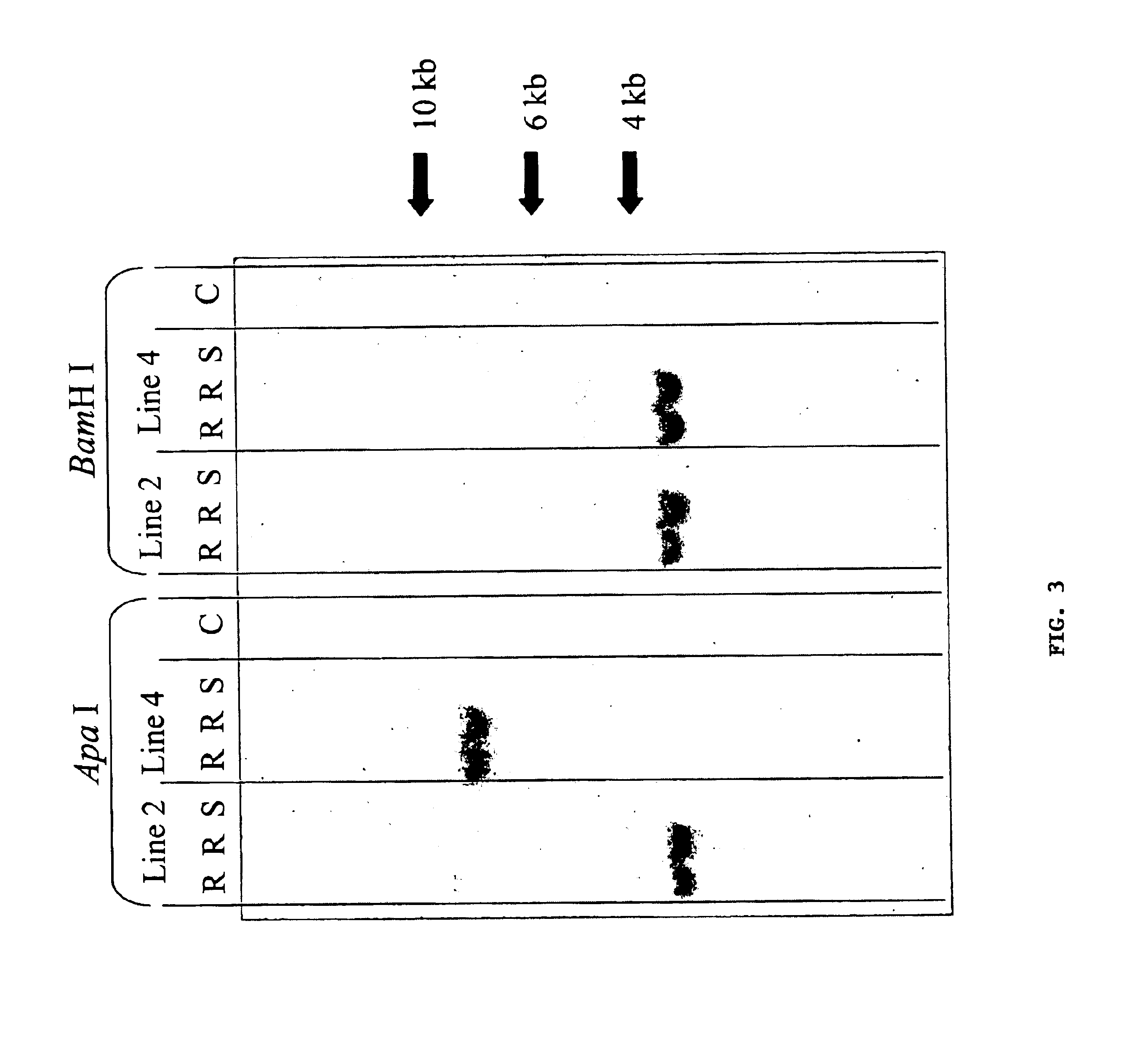Methods and means for producing barley yellow dwarf virus resistant cereal plants
a technology of yellow dwarf virus and cereal plants, which is applied in the field of methods and means for producing barley yellow dwarf virus resistant cereal plants, can solve the problems of reducing grain quality, sterility, and death or dwarfing as well as sterile heads, and reducing tillering.
- Summary
- Abstract
- Description
- Claims
- Application Information
AI Technical Summary
Benefits of technology
Problems solved by technology
Method used
Image
Examples
example 1
Construction of the Hairpin Gene (hpBYDVpol)
A full-length BYDV-polymerase (BYDVpol) sequence was amplified from a cDNA clone of an Australian BYDV-PAV isolate (GenBank Accession No. D11032) using GeneAmp XL PCR kit (Perkin Elmer), with a pair of primers (5'-ACCATTCTATTGTGCTCTCGCACAGAGATAAGCAGGAAACCATGGTTTTCGA AATACTMTAGGT-3' (SEQ ID No 3) and 5'-CCGGAATTCTTAATATTCGTTTTGTGAG-3' (SEQ ID No 4) that introduced a Nco I site and an EcoR I site at the 5' end and the 3' end, respectively. The underlined nucleotides are from the BYDV-PAV sequence. The resulting PCR fragment was digested with Nco I and EcoR I, and cloned into pUJJT (Wang and Waterhouse, 2000) at the corresponding sites, forming the Ubi1-JGMV5'-BYDVpol-tm1' cassette. A 1.6 kb sequence from the 5' half of BYDVpol was excised with Nco I and BamH I from the PCR fragment, treated with Klenow polymerase to generate blunt ends, and inserted into the EcoR I site (also pre-treated with Klenow) between BYDVpol and tm1' in the Ubi1-JGMV...
example 2
Transformation and Analysis of T.sub.0 Plants
A gene construct (hpBYDVpol) was made in which a hairpin RNA, containing BYDV-PAV polymerase gene sequences, is transcribed under the control of the maize ubiquitin promoter (FIG. 1). Using this construct and an Agrobacterium-mediated transformation system, an overall transformation efficiency of 13% was achieved resulting in 38 independent transgenic barley plants (Table 1).
Southern analysis indicated that 19 plants carried a single transgene copy, 12 contained two copies and 7 had three or more copies. The analysis of the first 15 of these plants is shown in FIG. 2. When 25 of the T.sub.0 plants were inoculated with BYDV-PAV, 9 of them appeared highly resistant as they supported little or no virus replication when measured by ELISA (data not shown). Six lines (1-6) were selected for further analysis; four of these appeared highly resistant and two appeared susceptible to BYDV-PAV infection (Table 2).
example 3
Analysis of T.sub.1 Plants for Response to BYDV-PAV Inoculation
About 20 seed from each of the 6 T.sub.0 Lines were sown in soil. The resulting plants were inoculated with BYDV-PAV and assayed by ELISA three weeks later (Table 3).
All of the plants from Lines 3 and 6 were as susceptible to BYDV-PAV infection as their T.sub.0 parents had been, whereas the progeny of each of the other lines (which were all resistant as T.sub.0 plants) contained some plants that were susceptible and others that were resistant. The T.sub.0 Line 1 plant produced a total of eighteen seed and of these only three germinated. One of the three plants that grew was found to be resistant to BYDV, while the other two were susceptible. The progeny of Lines 2 and 4 conformed to a segregation ratio of 3:1 (highly resistant: susceptible), suggesting the presence of a single dominant transgene locus in each line and Southern analysis (FIG. 3) revealed that the loci each appear to contain a single transgene. Plants from...
PUM
| Property | Measurement | Unit |
|---|---|---|
| pH | aaaaa | aaaaa |
| height | aaaaa | aaaaa |
| grain size | aaaaa | aaaaa |
Abstract
Description
Claims
Application Information
 Login to View More
Login to View More - R&D
- Intellectual Property
- Life Sciences
- Materials
- Tech Scout
- Unparalleled Data Quality
- Higher Quality Content
- 60% Fewer Hallucinations
Browse by: Latest US Patents, China's latest patents, Technical Efficacy Thesaurus, Application Domain, Technology Topic, Popular Technical Reports.
© 2025 PatSnap. All rights reserved.Legal|Privacy policy|Modern Slavery Act Transparency Statement|Sitemap|About US| Contact US: help@patsnap.com



